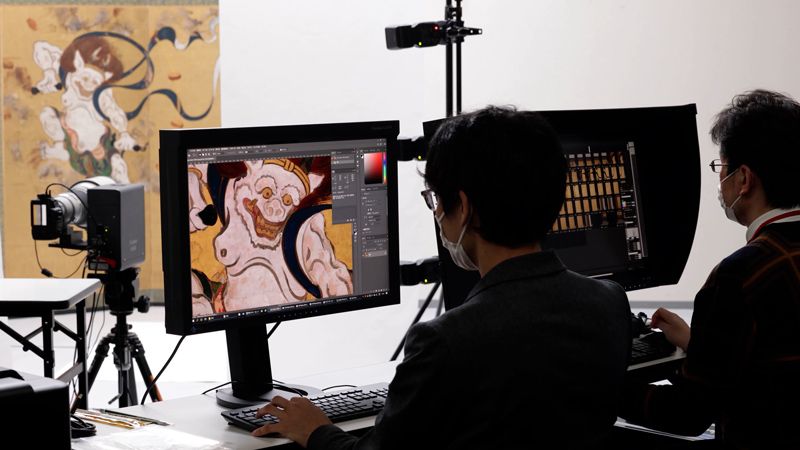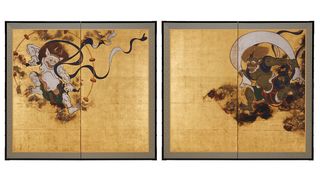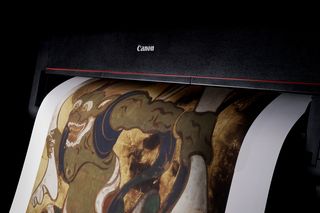Canon R5 used to create 4.2 billion pixel photograph of 17th Century Japanese art
Partnership between Canon and the Kyoto Culture Association seeks to create facsimiles of traditional Japanese treasures

Canon have recently preserved another cultural asset as part of the "Tsuzuri Project" (official title: Cultural Heritage Inheritance Project) aimed at sharing the beauty of Japanese culture with current and future generations through processes of producing high resolution facsimiles that reflect every detail of the original artworks.
“The Wind and Thunder Gods” is the latest famous Japanese cultural property to be preserved using Canon's state-of-the-art technologies, creating 4.2 billion pixel super high-resolution imaging through combinations of Japanese artisan skills paired with the company's image processing and printing technology.
· Read more: Best Canon cameras
The Tsuzuri Project fuses Canon's advanced imaging technology with techniques of traditional Kyoto crafts to produce and donate reproductions of valuable cultural Japanese antiquity assets, such as folding screens, sliding doors, and picture scrolls, for both current and future generations to enjoy and appreciate.

Canon cameras, particularly the mirrorless Canon EOS R5 are used to capture high resolution digital images of these artworks, images are then processed using Canon's unique precision color correction technology, and printed in their original size using large format Canon printers. By recreating tonal variations, brushstrokes, and the exact texture of the original, these significant cultural assets are reproduced as faithfully as possible, completed as near-perfect replications.
A joint-research project with the Kyoto Cultural Association and National Center for the Promotion of Cultural Properties (CPCP), the Tsuzuri Project has been active since 2007 with a main goal to preserve these important works, such as the recent facsimile created of the paired screens forming The Wind and Thunder Gods created by Tawaraya Sotatsu, regarded as a national treasure.
Watch video: Tsuzuri Project: “The Wind and Thunder Gods” (Canon Official)
Get the Digital Camera World Newsletter
The best camera deals, reviews, product advice, and unmissable photography news, direct to your inbox!
Traditional crafts are part of the overall process also, with gold leaf application and mounting work used in conjunction with digital technology. Using a specially designed pan-tilt head allows for multi-segmented photography assisted by Canon's color matching system, vastly reducing the time and effort required to produce the facsimiles, with color rendition that is said to be more faithful to the original assets.
Canon’s latest digital camera (R5) can shoot multi-segmented images using a specially developed control system, automatically controlling the camera with accuracy. The multi-segmented images are then digitally stitched together on a computer with deterioration resulting from image processing kept to a minimum, and image distortion caused by lens aberration also corrected.
The output is a result of the world's highest level of printing technology. The use of large-format printer, the imagePROGRAF PRO-4000, equipped with a 12-color pigment ink system to ensure that cultural assets are printed accurately. The traditional Japanese washi paper was specially adapted through research and development to enable quality and print on silk paper.

Once the work has been digitally printed on washi and finished with gold leaf, gold paint and isinglass it must be mounted on an authentic Japanese sliding door or folding screen by a master craftsman, of whom is responsible for restoring mountings and various cultural assets in Kyoto from ancient times.
As for the original works, they are kept in more favorable environments, to prevent deterioration and pass down cultural heritage to future generations. Facsimiles are donated to the owners of the original works, to shrines, temples, and museums that owned them once before, or to universities, local authorities, and some schools that use the facsimiles as 'living aids' for teaching Japanese history, art, and culture.
All Japanese cultural assets that have been restored thus far can be viewed on the Tsuzuri official website along with more information and updates on current workings of the project.
· Read more:
Best lenses for the Canon R5
Best Canon printers
Best Canon lenses
Check out this 717 GIGAPIXEL photograph of Rembrandt's The Night Watch!

Beth kicked off her journalistic career as a staff writer here at Digital Camera World, but has since moved over to our sister site Creative Bloq, where she covers all things tech, gaming, photography, and 3D printing. With a degree in Music Journalism and a Master's degree in Photography, Beth knows a thing or two about cameras – and you'll most likely find her photographing local gigs under the alias Bethshootsbands. She also dabbles in cosplay photography, bringing comic book fantasies to life, and uses a Canon 5DS and Sony A7III as her go-to setup.